The Early Years
Childhood. Starting my first job.
1969 - 1986
Jakobstad, Finland
Childhood. Starting my first job.
1987 - 1990
Jakobstad, Finland
Graduation. Golden Invest. Military service.
1990 - 1992
Jakobstad, Finland
This is where it happens! 2 years; all up, all down, Crashed & burned. The Best School Ever.
1993 - 1995
Stockholm, Sweden
Exposed to "life". Learning about people.
1995 - 1998 (-2003)
Stockholm, Sweden
Did all, learned it all, systematic profits were the takeaway.
1998 - 1999
Stockholm, Sweden
It works!
1999 - 2008
Stockholm, Sweden
IKEA Barkarby store: Improving the Check-Out Operations, Adding to the IKEA Concept, Business Navigation: €100M Budget x 4. Safety & Security, a fore-runner. The birth of IKEA staff planning.
2008 - 2010
Yekaterinburg, Russia
Real success. Tasting Good! A Family Milestone.
2010 - 2012
Khimki, Moscow, Russia
Size & impact.
2012 - 2015
Khimki, Moscow, Russia
Establishing the Risk function for IKEA Retail. The most exciting job ever... WOW. What a blast!
2015 - 2017
London, UK
Opening new units in the UK and Ireland.
2017 -
Yekaterinburg, Russia
Return to Yekaterinburg. Nearly two years in, its cold and long winters... mabye warmer lands is next?
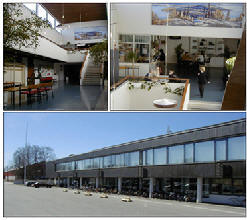
Jakobstads Handelsläroverk as it looks around 1990
Golden-Invest
During 1987 global stock markets had been booming for a few years already. By the fall of 1987, I registered my second business. "Golden-Invest" was kind of a mini holding company for trading stock at the Helsinki Stock Exchange. Business was very good in relative figures, but the total volume was very small. The success came more from the market boom than from my skills, I guess. I had been dealing with stock since 1984, but now it was structured in the form of a small business.
Golden-Invest and I drew attention from the media when I bought stock in a national insurance company, Sampo, through direct mail marketing.
Sampo prepared their listing on the Helsinki Stock Exchange by giving out shares to their insurance customers. Sampo had a huge market share with a very large number of holders of very small insurances. The masses, in reality nearly every household, would receive a share in the Sampo insurance company.
My idea was simple - I bet on the fact that most people will not be interested in "owning & managing" their only one (1) share in Sampo, especially as nearly all do not have other shares or even know how. Also - there was no set price known before the listing, so whatever I offered, would likely look like "manna from heaven".
My youth, I was 18, and the unusual way of obtaining unlisted stock: direct mail marketing, gained the attention in local and national newspapers. Golden-Invest was an unknown actor, of course, in the financial arena, and there where unfounded speculation about a possible hostile takeover by the unknown Golden-Invest.
This was relatively successful up to the point of media attention. Some stock where actually obtained in this way and profit was made in the end - 5 times the invested money, I think it was. Not bad.
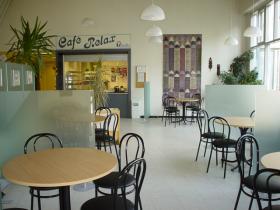
Brick and mortar" business came into my head...
While studying, the student organization offered me a seat on the board. Acting as a member of the board and the cashier for the student organization, gave me the opportunity to supervise and administrate their café business. It's not much to learn, almost anyone can do this if you have ever been a customer, but still, it was useful and maybe more importantly - it was inspiring, because I saw the margin in the restaurant business...
After graduating as a Bachelor Of Business Administration in 1988, I worked as a driver at a delivery company. In the fall of the same year, I was off to military service for eight months.
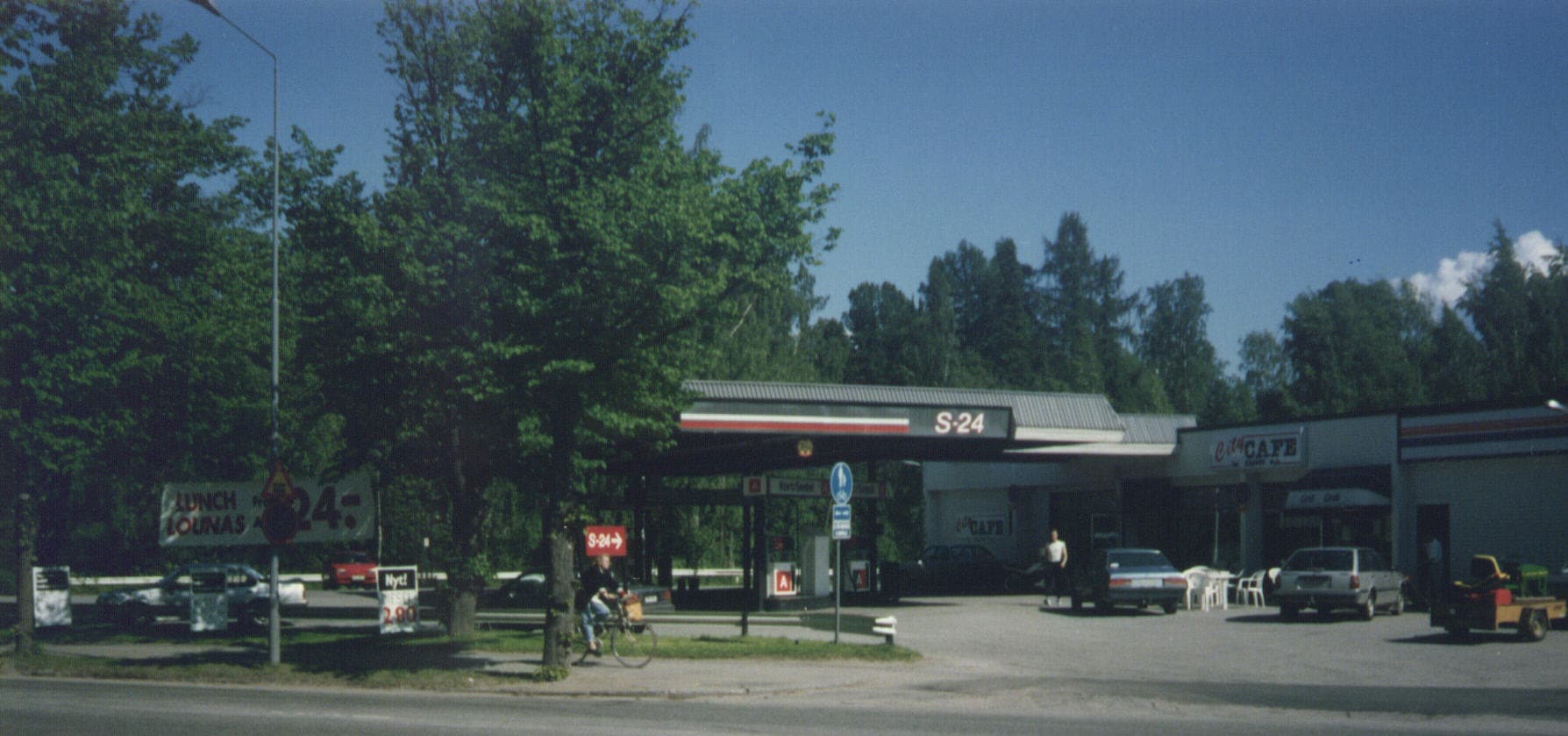
Picture from summer of 1991: This where the time, when you could have a lunch for € 4.00 ($4.67) and the gas price was € 0.47/liter ($2.08/gallon). The old Union branded gas station, where rebranded with S-24 and the shop premises, were renamed: City Café.
Going Up: City Café & S-24
The old Union gas station was to be transformed from a full-service station into a 24h automated gas station with adjacent and independent café/restaurant and service functions.
After successful negotiations, the new business was taken over and started in November 1990. The existing business with Café Relax and Beda Kantin now got the addition of City Café and S-24. S-24 was the automated around the clock gas station and City Café was a diner/restaurant with a car wash.
The diner had seating for 50 guests, a table tennis room as well as a hole-in-the-wall service to outside walk-up guests. The diner also had flipper games and slot machines. Opening hours where from 7 am to 1 am. The total hired crew peaked at 11. Both owners, now age 21, were working fulltime in the business that was relatively extensive.
Taking market shares for NESTE
At that time there where 11 businesses selling gasoline in Jakobstad. At our take-over, the S-24 had a sales volume rank of 10 in Jakobstad. We applied a very aggressive pricing policy, enabled by our NESTE agreement and in three months we moved the sales of gas from rank #10 rank to #2. We stayed on 2nd rank for 18 months, from March 1991 until we signed off in September 1992, with a sales volume close to 250,000 gallons a year.
The Struggle
Our money generators were gas sales and flipper & slot machine commissions. Our rapid expansion had initially drawn a large loss on the new business and liquidity became an issue. In 1991 I bought out my best friend and took over the business as the sole owner. The restaurant operations were rapidly and successfully turned into producing a profit.
Going down
However, the expansion had been too fast and early losses, too large. Consequently, I had to terminate all restaurant operations in early 1992 while keeping the S-24 part of the business till September.
A lot of work & learning... in a short time
During 1991 I worked a total of 5,200 hours, which is to be compared with a normal fulltime job of only 1,900 hours a year. That's almost 3 years-in-one! This was the best school ever.
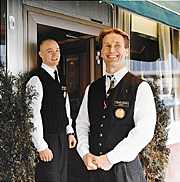
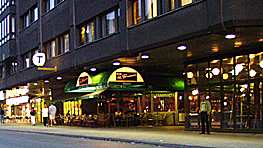

Back in 1992, the Finnish economy was in a deep recession after the collapse of the Soviet Union - Finland's most important trading partner. Large unemployment followed and a lot of people and businesses struggled. As much as one in four persons below 25 were unemployed. Staying was not an option. By the end of January 1993, I and my best friend left Jakobstad, Finland for Stockholm, Sweden, pursuing the hope of a better future.
On arrival in Stockholm, I was determined to learn and fully understand the restaurant business. I started working at a nightclub, Tre Remmare in Stockholm City. Coming from a small town like Jakobstad to Stockholm, was in itself a valuable experience. Working at a downtown nightclub and seeing the nightlife of Stockholm really widened my horizons in the overall looking at people's lives and destinies.
Tre Remmare was a restaurant business in Stockholm, located at Vasagatan 7, near Stockholm Central Station.
It was a busy place, at the time, one of the largest restaurant businesses in Stockholm. It was open from 11 a.m. till 5 a.m. in the morning, 365 days a year. At Tre Remmare I learned what a classic restaurant business is and how its run, but more importantly, I learned a lot about people.
I started as a busboy and later on worked in the bar and as a waiter. During the summer, we served 4 000 beers a day from the 95ft long bar, averaging some 500 gallons of beer sold a day. 7 days a week. That's big numbers for any bar or restaurant. There is still a bar at the same location, but is now redesigned and carries the name The Bishop's Arms.
I worked at Tre Remmare from 1993 to 1995, having lots of fun while learning a lot from my highly skilled colleagues. This was a truly great place to work, where everyone felt welcome and cared for. That's why the guests felt that too...
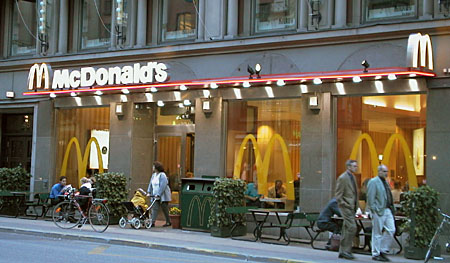
For many people, McDonald's is the first job they have. I was 26 when I started at Swedens first McDonald's, opened back in 1973. At the time I joined, this was a franchise, located at Kungsgatan 4, Stockholm. The owners had been operating the restaurant since 1986. I can still today say, that this was my best employer, all time.
I started as everybody else in the kitchen, with cheeseburgers and after the first day, I was absolutely convinced that I had made a mistake and wanted to quit. But for some reason, I went there for a second day.

In 1998 I left McDonald's for Kantin Moneo, where I became the restaurant manager. I wanted to implement the McDonald's business system in the traditional restaurant business.
Kantin Moneo gave me this opportunity. It was the perfect place to test my theories.
Kantin Moneo was a newly opened restaurant within the Museum of Contemporary Art (Moderna Museet) at Skeppsholmen, an island in the center of Stockholm. Kantin Moneo was owned and operated by two of the most famous names in the Swedish restaurant industry, Olle Lindberg, and Carl Jan Granqvist.
Kantin Moneo consisted of a large self-serve restaurant, an A la Carte restaurant and a small but exclusive little bar in the adjacent Museum of Architecture (Arkitektur Museet), called Bloms Bar. There were also extensive conference and event operations. Three-course dinners where served for up to 400 guests.
Once, an evening in the fall of 1998, we served 750 eating guests simultaneously. We had 400 guests upstairs in the restaurant and 350 in the conference.
Frequent visitors, guests, were from the social and cultural elite of Stockholm and Sweden. Among the more prominent guests, where the King Carl XVI Gustaf of Sweden, then Prime Minister Göran Persson of Sweden and other cabinet members as well as other members from the royal court and the cultural elite. Events were held by the CEOs of listed corporate companies, like Ramqvist of Ericsson and others. The self-serve restaurant where frequented by visitors to the museums, both locals and a lot of tourists.
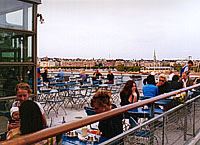
In summary, this was a very exciting work environment and I remember this as a fun time. My mission was to put profitability into the new restaurant.
I used the experience from McDonald's to set up steering parameters for the profitability and crew management. I considered the results a success since the productivity was increasing rapidly.
IKEA Barkarby store: Improving the Check-Out Operations, Adding to the IKEA Concept, Business Navigation: €100M Budget x 4. Safety & Security, a fore-runner. IKEA staff planning was born.
After 11 years in the restaurant business, I felt there where little left for me to prove there. The next step was to leave my restaurant career and move over to retail.
By now, I was equipped with extensive operational experience, good leadership skills, and ability, combined with a strong ambition to "systematically make profits", I concluded there is more to both prove and improve, within retail.
The choice fell on IKEA with its unique concept and unprecedented success. The founder of IKEA, Ingvar Kamprad, is a tycoon that has built one of the worlds largest retailing brands and this without listing his company on any stock exchange. Kamprad has kept the company in family control and IKEA is growing from profitability, within its own business. Profits provide and feed the growth of IKEA.
Improving the Check-Out operations
I started at IKEA in 1999 as a Deputy Check-Out Manager at IKEA Barkarby store.
IKEA is very strong when it comes to purchasing and logistics, as well as in sales concept. I discovered that IKEA's potential at that time were to be found in the fields of controlling and administration.
Immediately I started working with co-workers scheduling and co-worker training. With my colleagues in the check-out management team, we reorganized the recruiting process and staff schedules to be more flexible.
Co-worker training was developed with a better security focus and documented. The same co-worker training program was used for many years after, possibly some parts still used today. We had a team of 100+ cashiers working at the check-out.
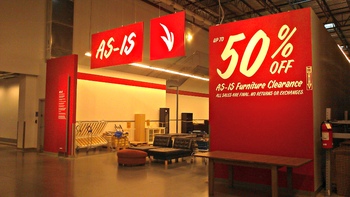
IKEA - Adding to the IKEA concept
In 2001 I was given the opportunity to take part in a global project within IKEA with the objective to recover the cost of goods returned. The idea and process were invented in the IKEA Seattle store a few years before and this project was to test the process in four stores in Europe. The process should work in two ways; reducing reason for costs and recover costs acquired. The project objective was to create a new addition to the IKEA concept including a new department to be added to the chain of nearly 200 worldwide IKEA stores.
I was the Project Leader and Department Manager of the Recovery Department at the IKEA Barkarby store, north of Stockholm. The Barkarby store was one out of four stores, picked out for the testing of the Recovery Project. The store projects were supervised and financed directly from the Regional Headquarters of IKEA Europe.
For one year the operations were tested, organized and retested and documented, thus becoming the newest addition to the IKEA concept. The pilot departments at the four stores were considered to be a success and the first version of the concept manual was named "Working with Recovery - The IKEA Way".
The new concept was implemented in IKEA stores worldwide in 2002 and 2003. After the project, I continued as a Shopkeeper for Recovery in the Barkarby store.
The success with implementing the new Working with Recovery - The IKEA Way concept added around 10 % directly to the IKEA Group bottom line as an eternal effect, year after year. The recovery projects also took the IKEA store controlling one step further as well as started the work now known as IKEA sustainability. The addition of the Recovery process is arguably on the top 10 list of most important changes to the IKEA concept in the past 20 years. There is reason to be proud for everyone involved.
As an IKEA store visitor you see the Recovery process in the form of the "Bargain Corner" or "As-Is". In Sweden it is called "Fynd".
Safety & Security
From 2004 to 2008, I was the store security manager at IKEA Barkarby. This job was both very interesting and fun, aiming to prevent and also investigate different types of fraudulent or criminal activities, both internal as well as external.
Responsibilities also included safety; preventing losses due to hazards like fire and accidents.
I'm proud to say that the safety & security at IKEA Barkarby improved from a very good level and placed the Barkarby store on the IKEA-map as a fore-runner on Safety & Security issues. Because of this, I had the opportunity to take part in the training and development of my colleagues in other IKEA stores both in Sweden and in Russia, including some Country Safety & Security Managers. I was also happy to be repeatedly consulted on specific issues both nationally and globally.
In 2007, I was in focus because of a software tool, I created in VBA for Excel, enabling cashier performance monitoring, by collecting and showing statistics in Excel. The visual basic code also scanned for risk factors relating to cashiers' behavioral patterns and signaled when attention is required. The tool was implemented in all the stores in Sweden in 2007 and provided department managers easy recognition of whom in their teams were in most need of focus and attention.
Background
While primarily in the role of Store Safety & Security Manager, I also did the yearly goal figures and budget for the IKEA Barkarby store. As such, naturally continuously involved in the store performance potentials and with the staff planning and performance navigation so close to my heart, it was only a matter of time...
and:
In 2005 I showed the principle of McDonald's staff planning to a colleague on the whiteboard in one of the conference rooms, named TUNNAN, pointing out the distance between IKEA in 2005 and McDonald's as I knew it in 1996, nine years earlier through the use of their software, McSchema.
200 1 - Early experiments
Before this, while in the Recovery department 2001 - 2003, I made schedules for my team with Excel sheets based on the McSchema forecasting and scheduling software tool that McDonald's had in 1996. But it was not before this occasion in 2005, I put the staff planning potential at IKEA on the table.
2005 - THE BIRTH
My colleague managed to create interest in the staff planning potentials in IKEA and we started to look at how this could be done. My colleague, was my manager and later my Store Manager in Yekaterinburg store. We moved there simultaneously and worked together there for 2 years after Barkarby.
Our early efforts in Barkarby inspired other stores to start working with staff planning as well and there were a couple of different approaches to it around in the very beginning.
2006 - SWEDEN
In 2006, IKEA retail in Sweden dedicated resources for working with staff planning as a nationally supported potential. The first IKEA common tool launched was called "BAB", short for the Swedish words, Behovs Anpassad Bemanning, an approximate translation would be something like Need-based Staffing. This was building exactly on the base principle of matching a workload with a human resource like it was described in the McDonald's Operational Handbook already in 1980's or most likely even long before. The staff planning principle is no rocket science.
However, the first versions did quite a weak job of matching the need with the working schedules. The early IKEA focus was mostly on the mechanical creating of schedules themselves after and according to one and the same set of rules. An important step and pre-requisite for continued development, of course.
2008 - RUSSIA
In Barkarby and later in Yekaterinburg, we continued to develop the Staff planning process. With more freedom on this topic and larger potentials, the staff planning process matured quite a bit in Russia. My Store Manager and colleague managed to sell the idea for national implementation at IKEA Retail Russia as well. A project manager was assigned for implementing the Staff Planning Project in Russia, placed with us in Yekaterinburg, we designed and tested it there, before it was implemented in the other stores.
By 2010 the Russia Staff Planning Project was rolled out to all stores in Russia and when I arrived at IKEA Khimki, I had the opportunity to continue to work with this in the 3rd store, still pushing and contributing both nationally in Russia as well as in Sweden and with some occasional global contribution. Our fantastic Store Staff Planning Teams in Yekaterinburg and Khimki were very important contributors to the developing staff planning in 2008 - 2012.
HARVESTING THE RESULTS
The customers and co-workers are always the main beneficiaries that harvest the result of Human Resource Planning well done. At IKEA Russia the started staff planning in Yekaterinburg spread to many other stores and made a significant contribution to the fantastic growth in customers and sales in the Russian IKEA stores during this period.
2011 - IKEA WORLD
Other countries picked up the Staff Planning potential and by 2012, when I moved on to the IKEA Risk function, it was on the agenda in several IKEA country organizations. However, Russia were still leading the pack.
By 2015, on my 20th Anniversary since working with McSchema at McDonald's, there was a global matrix support organization for the staff planning topic at IKEA Group, supporting all IKEA countries with their staff planning potentials. I'm very proud and happy I had a chance to initiate, inspire and influence the staff planning at IKEA and of course, this is one of my biggest achievements at IKEA.
I actually never had staff planning as my main role, but it was by my side all the way since McDonald's. I did not contribute anything to the development of the IKEA staff planning after 2012, but I have personally created the training material and trained many of the people now working with staff planning inside and outside IKEA in many countries around the world.
IKEA's approach to Staff Planning was born in Barkarby in 2005, that's when and where it all began. Now you know.
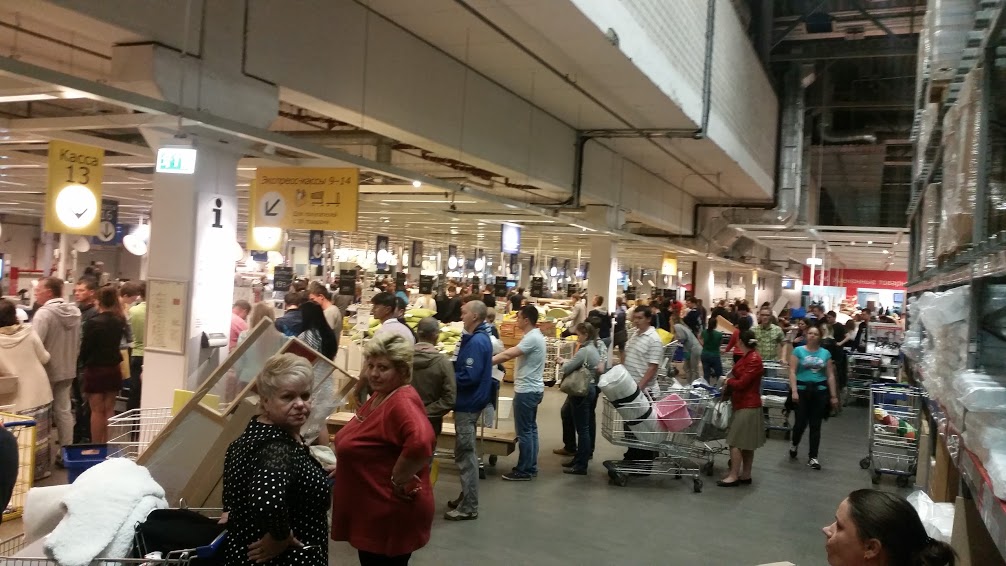
Picture show people queuing to the 44 open [all] Check-Outs on June 5th, 2016 at 19 min. past midnight. This is the night between Saturday and Sunday. The store is open from 10 a.m. till 2 a.m. 365 days a year. I took this photo while there, shopping for a METOD kitchen.
After two years in Ekaterinburg, I was assigned to IKEA Khimki store in Khimki, Moscow as the Business Navigator & Operations Manager, arriving in Moscow in September 2010.
IKEA Khimki was at that time the second largest IKEA store in the world by EUR turnover and in m3 turnover. In 2010 IKEA Russia had all 3 stores in Moscow on the global top 10 list, with IKEA Teply Stan as #1. Size matters and IKEA Khimki was a flagship within IKEA, globally, with the Russian headquarters located on its roof, making it a constant destination for internal visitors from all over the IKEA world. Being a member of the Department Head team in this store was a true honor and privilege.
To further emphasize the size, IKEA Khimki store produced more EBIT profit in a month than all the 17 stores in the [at that time] constrained UK did in a year. Another example, the sales turnover in EUR were larger than all the IKEA stores in Finland, or Portugal, together. I like and liked to boast about that.
Being the Business Navigation & Operations Manager in this store, 2010 - 2012, was a very interesting and challenging period. Being of this size, located where it is and heavily underdimensioned for the commercial load it successfully performed in - made it possibly the hardest IKEA unit to run, anywhere. To make it possible, we had a store team of 800 fantastic people that came through every day.
My contributions to the Khimki development mainly comes in terms of pushing and expanding the capacity limits inside the excisting walls, while keeping the operation safe. Tools and methods used are very much the same as used in Yekaterinburg, in the Barkarby store, at Kantin Moneo and McDonald's. BUT - it was and always is all the people working together that makes the everyday wonders come true.
Yes, the McDonald's methods for systematically making profits really worked at IKEA too... and still works. Yet, IKEA has so much more to learn from McDonald's and many others...
IKEA's founder, Ingvar Kamprad, said it best: "Most things remain to be done".
If you want to know more, don't hesitate to contact me.
IKEA Russia Risk - before me
IKEA Russia started as one legal entity and opened the first store in Khimki, Moscow on March 22, 2000. Just to be clear, of course, they had a Safety & Security organization from the very start, long before the opening of the first store. IKEA Russia had a very rapid expansion in the period 2000 - 2009, shifting the focus from retail only to property investments, building not only the stores but the gigantic shopping centers they were located in. IKEA's Russian organization build and opened 13 shopping centers with IKEA stores in this period. Samara was opened in 2011, as the #14.
Up to 2012, there was only one Risk organization to cover for all shopping centers, IKEA stores, warehouses and factory functions. IKEA Industry then called Swedwood had their own risk organization located outside of Russia.
Quite understandably the competence developed with a focus to support the expansion and managing the shopping centers, that were around 5 times larger than the IKEA stores by m2.
At the starting point...
While I was in the Ekaterinburg and Khimki stores, I often ventilated the absence of true IKEA based retail competence in the then property oriented risk organization.
Consequently, I was appointed to head the opening and startup of a dedicated risk organization for IKEA's retail operation in Russia. I started in the role of Country Risk Manager for IKEA Retail in June 2012.
The responsibilities included all IKEA retail operations in Russia and partly for Ukraine and Belarus as well, it turned out. At the time, there were 14 IKEA stores, 1 Distribution Centre and 1 Furniture Factory. In addition, there were 3 sourcing offices located in Novosibirsk, Russia, in Kiev, Ukraine and in Minsk, Belarus and of course the Headquarters for Russia on the roof of the Khimki store, also including a large sourcing office. The headquarters in IKEA is called Service Office.
In figures, it would be something like 500,000 m2 (x10 in sqft) of rented space, more than 10,000 employees, 300 loading bays used by 500 forklift trucks loading 250 delivery trucks every 24h cycle, moving 3,000,000 cubic meters of goods yearly. Almost 200,000 store visitors on any given day, 365 days a year. In short, it's everything but small.
All in all, it pretty much guarantees an interesting working day, every hour of every day - for the Country Risk Manager and his Retail Risk Team.
IKEA globally provided a set of rules that the IKEA stores are expected to comply with. For follow-up there is a review process, internally called the SecCheck. All the reviewers were from the property organization and without any experience from IKEA stores.
The pictures above give some flavor of what this assignment contained.
Objective
The primary purpose and objective of the Retail Risk Function were to provide and supervise the ability for IKEA Retail to detect, react and prevent any and all risks that could obstruct normal running business operations and growth. This was not a consulting function, there was a clear expectation and near unlimited mandate to take operational lead in achieving the objective.
'Meeting the Customer' Focus
I'm very proud of the introduction of retail only risk organization that comes from, works in and for the stores. I set out to convince and promote what I called the Retail Risk Direction, containing 5 keywords around which the change was launched. All aiming to integrate the IKEA retail thinking and needs of a meeting the customer focus when working with Safety & Security.
To really crystalize the focus, I initiated a split of the risk organization, so that the distribution and sourcing parts of IKEA Russia got their own independent risk function as well, making it 3 independent risk organizations working for IKEA Russia, in addition to the IKEA Industry Risk function working for Russia from Sweden.
Leaving IKEA Russia for the UK organization, I handed over the Risk function in the hands of a previous Restaurant Manager turned Country Safety & Security Manager. I'm very happy with the change and shift of focus achieved, returning it back to the IKEA shop floor for the benefit of IKEA shoppers.
What were the main challenges?
Compliance
Compliance with the laws and regulations can be very challenging and demanding. The chosen approach to address this was focusing on change of mindset internally, preparedness with more internal reviews and checks, increased knowledge about what to comply with and why.
The general compliance measured in reviews and visits by authorities showed a very good development. So good, in fact, that I changed the Compliance keyword in my Retail Risk Direction strategy to Systematic, indicating the next level of challenge.
Reporting
To get the people in all parts of the organization to systematically report and document detected issues was a very important barrier to overcome. Having a systematic reporting process is the base for any consistent and systematic work with prevention.
The ability to document and record reports increased dramatically. Again, clearly communicated expectations, good support & guidance, and strong follow-up was the main game changer.
Corruption
The challenge with corruption lies in the ability to detect and recognize it. I reached a good level of understanding corruption on the Russian market, but I am sorry to say that very little was moved forward on this topic passed the level of reaction on detected cases.
The types of corruption IKEA Retail in Russia was exposed to, is usually visible through low quality in maintenance and construction works, but also in more classic areas such as embezzlement and fraud. Example of severe consequences of corruption can be fires, electrical accidents, and failing equipment systems etc..
External theft and fraud is a smaller problem at IKEA in Russia than in other countries in Europe and overall a relatively small issue compared to other retailers.
Unforeseen Event Handling
All big corporations have some type of Crisis or Emergency Management structure in place to handle situations that the normal business structures are not intended for.
At IKEA this is designed globally, mostly based on context expectations more relevant to the stability of, for instance, the UK or Sweden, rather than for the more vibrant and vivid business life in Russia.
This made me craft a simplified version of the internal global expectations on defining emergencies and crisis. Basically, the approach was to downsize the grade, as the running business organization in all units are much more resilient, experienced and better equipped to react to unforeseen events.
Instead of working with a full scale, crisis management or emergency response team, I usually satisfied with something I called, Focus Groups, smaller constellations of a couple of people spontaneously put together depending on the need of the day.
It was not possible to tie up large parts of the most senior management for all the events that would fit the European designed structure. I was very content with the efficiency, flexibility, and capacity that was the effect, but I am aware that it occasionally caused some annoyance in the IKEA organization outside Russia.
In the end, it was a very successful approach and I am very thankful for the mandate, support, and freedom I had, to work with what could be called Unforeseen Event Handling. In the right context, this approach could work in other places too.
After 7 years in Russia, I jumped on an opportunity to change Moscow, Russia for London, UK. I shouldn't have, but I'm glad I did. I took on the role of Country Risk Manager for IKEA UK and Ireland arriving in London for my new life in the last days of August 2015.
It was a fantastic experience to come and set-up a new life in London. With my family, my then-pregnant wife and our 3 yr old daughter. We all liked London and already after two months, we were blessed with a son, born in Westminster. Our daughter did her first school year at the International School of London in Ealing and learned English properly.
Workwise, I was in the lead from the Risk function perspective in the opening of 6 new small retail units, Order & Collection points and two full-size IKEA stores, IKEA Reading and IKEA Sheffield. Clearly opening an IKEA unit is a success in any context. Doing it multiple times in a period, not even two years with limited resources is definitely something to be proud of. Again, I must thank all the very many contributors, as usual, its all about making everybody come together to make it happen. It was an exhilarating experience to participate in so many new unit openings in such a short period of time.
Without too many details, soon we discovered that we faced visa issues for some of my family members. This prevented us from settling in properly, made it impossible to make plans and limited our traveling in and out of the UK under much of the nearly two years we spent there. This became a dark cloud hanging over the whole otherwise fantastic London experience. In the second year, not seeing any clear timeline for a solution, I decided to check out from London.
Of course, this was a very challenging decision to make, but as always - big changes gives birth to new beginnings and for this, I am very grateful.
On the total, we liked Ealing and London and could definitely see ourselves living there, if the context is right, who knows what the future could hold...
We left London in early July 2017.
In July 2017 I returned with my family to Yekaterinburg, Russia, 7 years after leaving for IKEA Khimki and 9 years after arriving here the first time.
Now in my 50th year, I appreciate it has been good to have more than a year of reflection and the luxury of rethinking what I want going forward.
The first year back here in Yekaterinburg was a lot about the family and to sort out my Residence Permit, which I now have. I also registered DAXION in Russia, a legal entity provide a lot of options for business opportunities.
The future is an open book, waiting to be written... come back, follow me and see what the next chapter will contain.
THANK YOU!
Thank you very much for dropping by and if you have read all this page all the way down here, you have done a great job. I hope you enjoyed it and maybe you leave inspired with some new thoughts or ideas.
I will like it if you would join me on facebook... See you there. I'm also on LinkedIn.
... what the future holds, no-one knows - That's what makes it so incredibly inspiring and interesting to explore.
In the last years, a few larger changes have been observed. They are on the scale that hasn't been observed for a couple of generations, maybe never before even, it's hard to say. I'm thinking of 2 before others;
- The Speed of Change itself, its faster than ever before and accelerating. In e-commerce, for instance, essentials known in marketing five years ago is almost totally obsolete now. We need to learn faster and in front of all, adapt to an accelerating speed of change.
- A New Emerging Consumer Group: Generation Z and beyond - with their very soon to be, and never before experienced, consumer expectations. How, why and where they will consume in the coming 5 to 10 years - will be very the fascinating to see... And who the winners will be?

Website Building Software
FOLLOW ME!